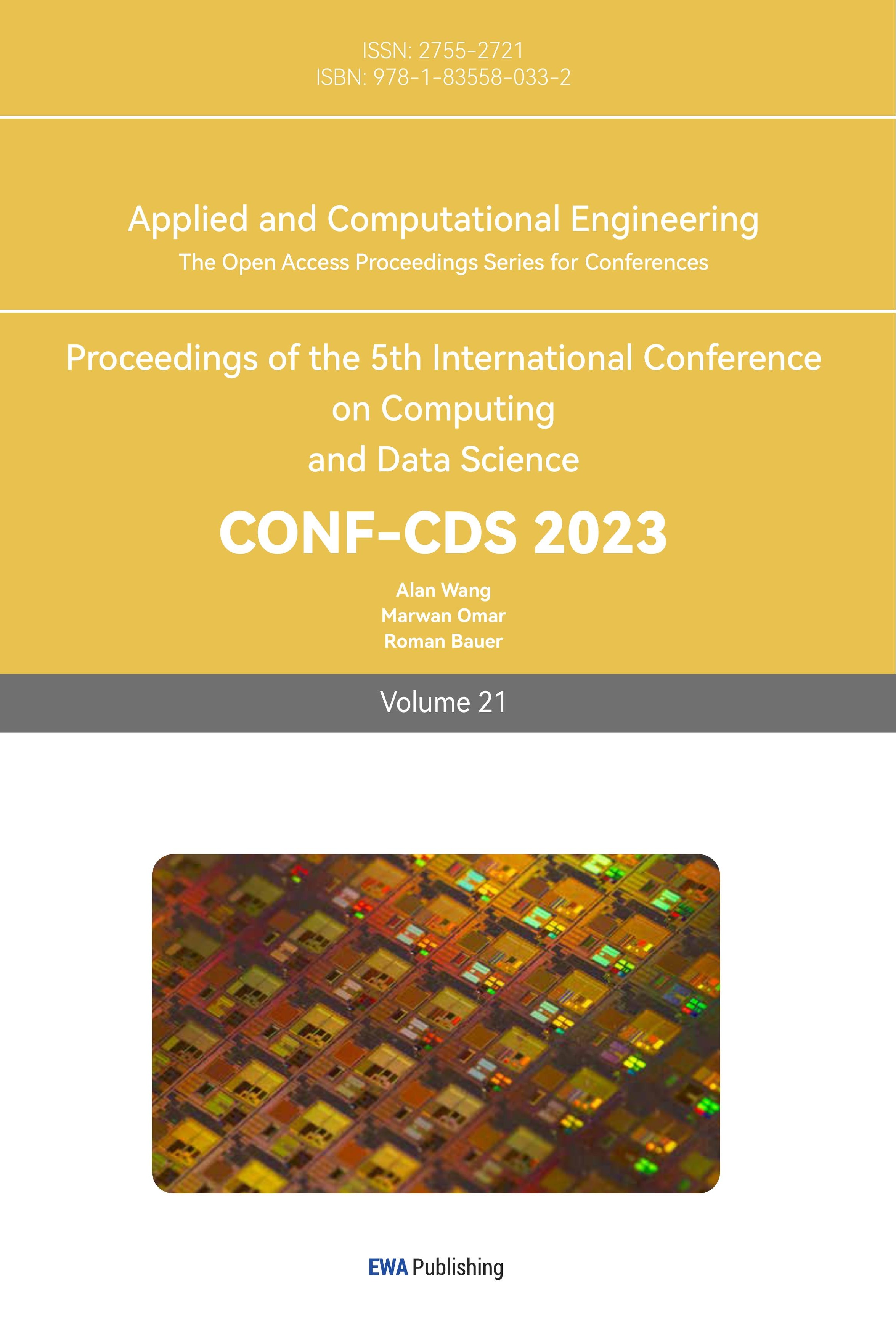1. Introduction
Contemporary university students are essential participants in a harmonious society and the creators of advanced productivity, ideas, spirit, and culture in our country [1]. As a fundamental information platform in higher education, the university management system APP consistently holds a central position in the development of higher education. One of the objectives of the university student management system APP is to maintain the normal teaching and living order in ordinary universities [2]. It has been observed that each school has its own student management system. However, due to issues such as excessive navigation, complex interface layout, and difficulty in locating the school system within the existing management systems of many universities, combined with the objective factors of the imperfect higher education system in our country, students are unable to quickly find the desired information. Therefore, from the perspective of the cognitive model, it is crucial to reconstruct the university management system APP and promptly grasp the needs and understanding of student users.
In recent years, there has been an abundance of research exploring innovative design in the relationship between student user information construction. These studies can be broadly categorized into the following three aspects. Firstly, some scholars have conducted research in various design fields based on the relationship between the cognitive model and information construction. For example, Mei Yu [3] conducted research on the interaction mode of application software, focusing on the relationship between information construction and user cognitive models, and applied the research findings to the development and design of a mobile internet application software. Luo Wenjun [4] utilized the ZMET [5] technique to explore the cognitive models of consumers towards smartphones, successfully constructing a consumer consensus map and designing and optimizing marketing strategies for smartphones. Secondly, exploratory research has been conducted from different innovative perspectives using various methods. Scholar Tong Qing [6] employed the goal-oriented design theory to design frameworks encompassing information architecture, task flow, information content, and security design. Dou Jinhua et al. [7] used scientific research methods such as the intention scale method to understand the cognitive models of target users, to some extent using the cognitive model of target users as the starting point for design. Thirdly, some scholars have carried out innovative research on different types of products. For instance, Zhang Yuqing [8] introduced the Kano model into the development and design of mobile application software, classifying user demand attributes and accurately constructing user role models using the Kano model. Cheng Dingwen [9] analyzed and researched the characteristics of cognitive models in the field of product design, systematically studying the relationship between product symbolism and cognitive models.
Through interviews, this study discovered numerous issues within the university management system. Therefore, by integrating and utilizing a series of cognitive models of university student users, this study extracted navigation elements at various levels to ensure the objectivity and effectiveness of the experimental materials. The hierarchical cluster analysis method was employed to ensure the accuracy of the experimental results. Finally, based on the experimental findings, the information architecture of the management system APP was constructed, and the navigation names, classification methods, and other elements of the university management system APP information architecture were redesigned to address the problems of information comprehension difficulty and complex management systems. This optimization aims to enhance the speed of information acquisition for university student users and increase their satisfaction.
2. Theoretical background
2.1. Information architecture
There are various definitions of information architecture, and the definition widely accepted by scholars is provided by Peter Morville and Louis Rosenfeld [10]. They define information architecture as the art and science of organizing information and interfaces, involving the design of organizational systems, identification systems, navigation systems, and retrieval systems. The purpose is to help people discover and manage information more successfully in the online environment and effectively address the information needs of learners. Information architecture (IA) and user experience (UE) are both emerging research fields that have flourished with the rise of the digital economy. Although they may seem unrelated, in recent years, there has been an increasingly apparent trend of their integration. This indicates that there are certain inherent and inevitable connections between information architecture and user experience [11]. Therefore, it is necessary to analyze and combine these two aspects, which is of great significance for further research and practical work on information architecture and the user experience of university students.
2.2. Cognitive models
The concept of cognitive models was first proposed by Scottish psychologist Kenneth Craik in his book “The Nature of Explanation” published in 1943 [12]. Cognitive models refer to the mental models individuals use to understand and perceive the surrounding objects [13]. By compiling data from domestic and foreign literature on cognitive models, a line graph depicting the annual research literature quantity from 2010 to 2021 shows a fluctuating upward trend, indicating an expected further increase in research output. The focus and trends of research, as observed in the CiteSpace software, mainly concentrate in the field of human-computer interaction. By conducting searches and analyses on high-frequency terms such as application software interface design, cognitive usability research, user experience, etc., and performing cluster analysis, it can be inferred that the research based on the theory of cognitive models primarily emphasizes visual research on application interface design, user research, and experimental validation in the field. Therefore, this study will investigate the university management system based on the theory of cognitive models.
2.3. Card sorting method
Card sorting is an effective and flexible design technique that helps understand how people organize information and how they perceive and describe information in different categories [14]. P. Morville and L. Rosenfeld also provide specific introductions to several different card sorting methods in their book “Information Architecture” [15]. However, the commonly used card sorting methods can be categorized into two types: open card sorting and closed card sorting. Open card sorting is more frequently used, and researchers can obtain more results from it, gaining a better understanding of users' mental models of the product. In terms of feasibility, open card sorting is highly flexible. However, it is not necessary for it to be entirely open; certain restrictions can be applied to the classification process. D. Spencer and T. Warfel suggest that 30-100 cards are the most suitable [16], but the specific number of cards depends on the actual situation. There are two ways to analyze the results of card sorting: qualitative analysis and quantitative analysis. Qualitative analysis may be somewhat lacking in standardization and is described by J. Nielsen as visual card grouping [17]. On the other hand, quantitative analysis is more standardized, using clustering to statistically analyze the classification results of users (usually in the form of dendrograms) to illustrate the relationship between two cards [18]. Therefore, this study adopts the open card sorting method for quantitative analysis to reconstruct the information architecture of the university management system APP.
3. Experimental design
3.1. Research object
This article focuses on the empirical research of the university management system app in a university in Yunnan Province. This study explores the problems existing in the management system app and extracts information through in-depth user interviews and tracking surveys. Based on the preliminary mental models obtained, a card sorting experiment is conducted. Fifteen university students, including 7 males and 8 females, with an average age of 22, were selected as participants. All participants have experience in using the management system app.
3.2. Framework process
The process of this study is illustrated in Figure 1. Firstly, Experimental Group 1 is designed to identify the problems of the student management system app through in-depth user interviews. According to Young, the mental models can be represented by a series of affinity diagrams of behaviors [19]. In order to facilitate in-depth research, this study explores the mental models of information retrieval efficiency of undergraduate students in the School of Art of a university in Yunnan Province in the form of affinity diagrams of behaviors.
Next, based on Experimental Group 1, Experimental Group 2 is designed to allow students to conduct card sorting themselves, which can accurately discover the mental models of the student users [20]. Through these operations, an empirical study on the information construction of the university management system app in Yunnan Province is conducted.
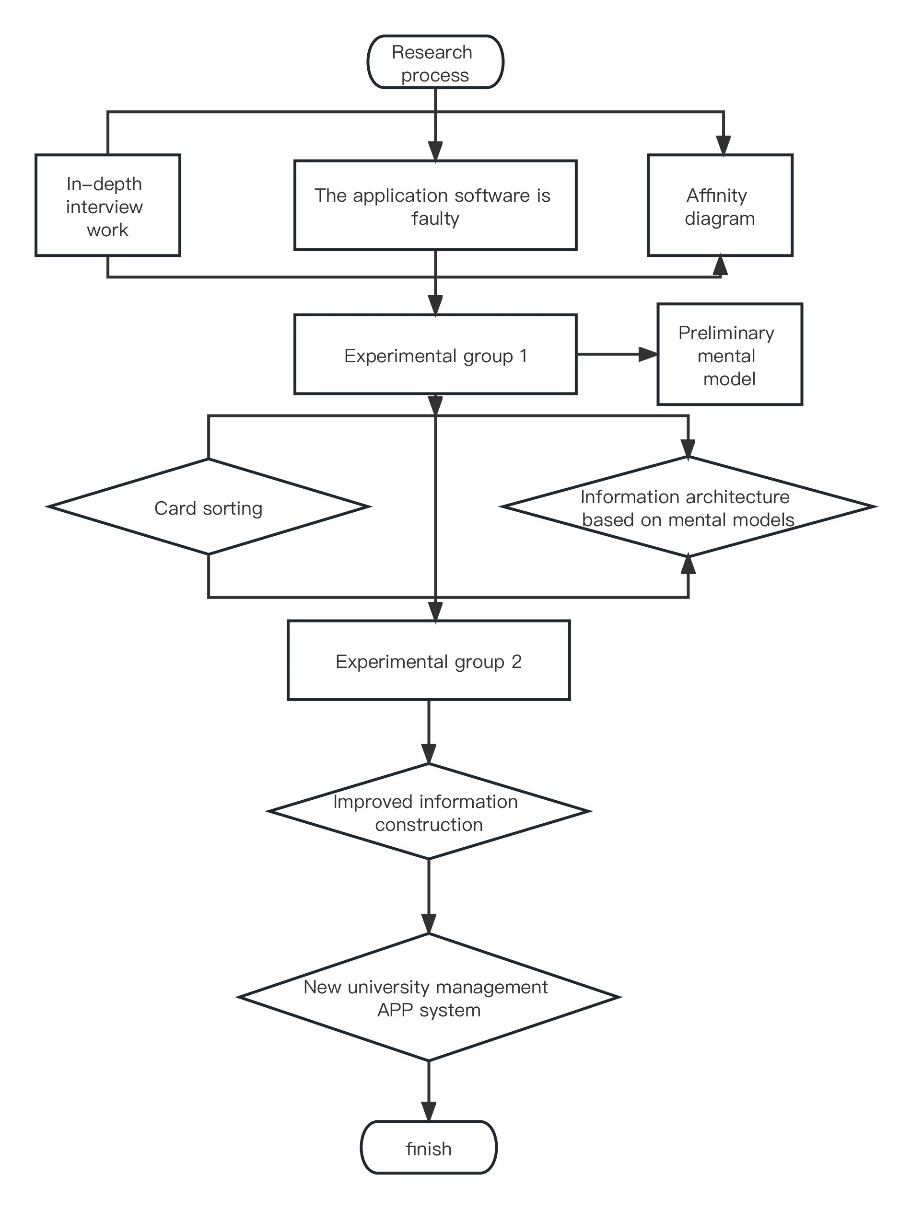
Figure 1. Framework process.
3.3. Experimental procedure
Experimental Group 1 involves in-class tracking surveys and interview methods in the School of Art and Design of a university in Yunnan Province. The whole process of the mental model is divided into three stages: the construction of mental space, the construction of typical scenarios, and the construction of role models.
(1) According to the division method of the affinity diagram of mental models, this study divides the mental space in the mental model of students' learning and daily life into three parts: pre-class preparation, in-class note-taking, and post-class information retrieval. Ten sophomore students majoring in art were invited as participants. They were asked to write down the vocabulary related to their daily activities using the theme of "a day." After simplifying and categorizing the vocabulary, 14 groups of vocabulary were obtained. Through preliminary in-class observations, the in-class note-taking part of the mental space was further divided into five groups, including teacher self-introduction, course requirements introduction, course content explanation, assignment after class, and next class information. Through preliminary user interviews, the pre-class preparation part of the mental space was divided into four groups, including waking up, having breakfast, going to the classroom, and finding a seat. The post-class information retrieval part of the mental space was divided into five groups, including reviewing notes, organizing notes, completing assignments, resting, and reviewing for exams. Each group can be further divided, for example, the waking up group can be divided into three subcategories: waking up, getting dressed and washing up, and going out. The entire mental space is shown in Figure 2.
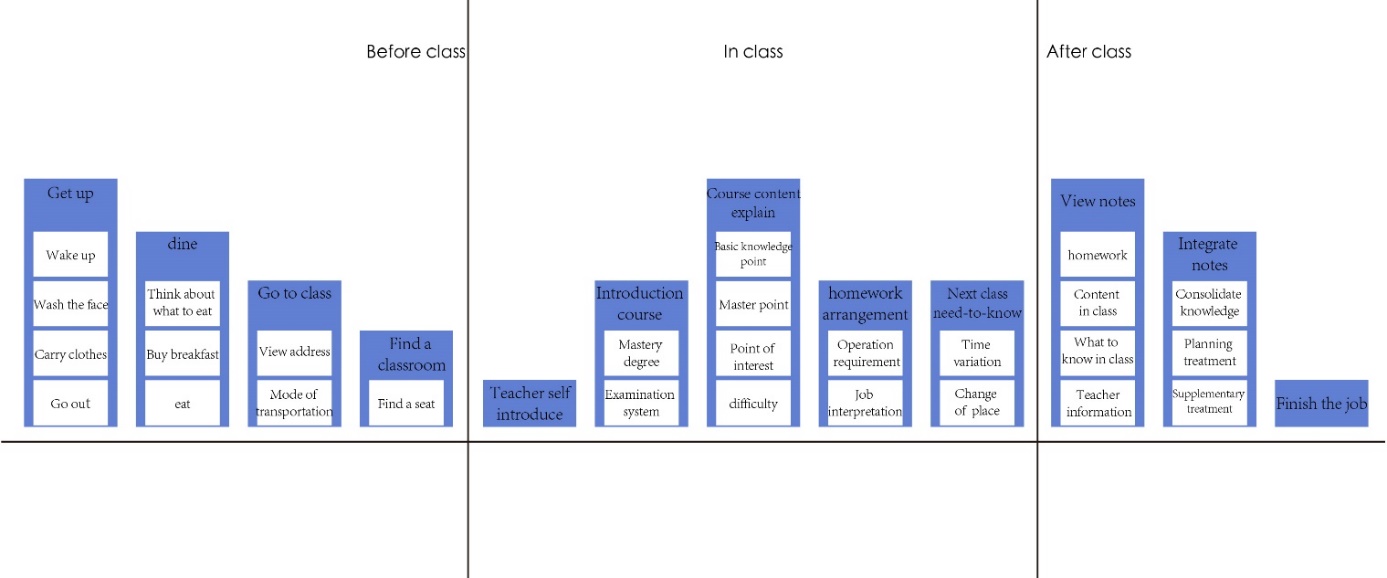
Figure 2. Mental space.
(2) Based on the key points of the pre-class and post-class parts of the mental space, preliminary interviews were conducted with two freshmen, two sophomores, and three juniors. Combining the observations and preliminary interviews of these two classes, ten typical scenarios were constructed, as shown in Table 1.
Table 1. Scenario construction.
Mental Space | Scenario | Scenario Description |
Pre-class | 1 | 1. Before going out, I have a look at the timetable and course syllabus on the system, then log out and have breakfast. |
2 | 1. Wake up in the morning and buy breakfast. The class is scheduled for the 3rd and 4th periods. 2. After breakfast, I return to the dormitory to read books, play games, watch videos, etc. and set an alarm for class time to avoid being late. | |
3 | 1. As a freshman, I’m not familiar with the school environment, and often take the wrong way and cannot find the teaching building. | |
In-class | 1 | 1. In the first class, the teacher introduces himself (I am xxx, email xxx, office xxx). 2. The teacher introduces the course requirements. |
2 | 1. The teacher’s PowerPoint is too fast, and it’s a bit difficult to keep up with note-taking. | |
Table 1. (continued). | ||
3 | 1. After two classes, the teacher assigns homework on the PPT or blackboard. 2. Students take photos or write down the assignments. 3. Some assignments require additional explanation from the teacher, but the teacher only explains orally, so students need to make additional notes. | |
4 | 1. I missed some content while taking notes. | |
5 | 1. Due to various reasons, the classroom is changed, such as insufficient seats in the computer room, or the classroom projector is broken, and it continues until the new chapel. 2. Students need to make notes to avoid going to the wrong classroom. | |
After-class | 1 | 1. If I didn't attend the last class or didn't have time to take notes, I need to borrow someone else's notes to supplement. |
2 | 1. The teacher recommended books, but I didn't have time to go to the library to find them. 2. I remembered the recommended book when I returned books to the library, but I didn’t bring my notebook. | |
(3) Based on the above-mentioned 10 constructed scenarios, interview outlines were designed. In-depth user interviews were conducted with three junior students, three sophomore students, and four freshman students majoring in art and design, totaling 10 participants (5 males, 5 females), and the interviews were recorded. The interview results were integrated and analyzed, resulting in three user role models: self-disciplined, moderate, and dependent. From the student role models, it can be observed that the moderate and self-disciplined role models are the main characteristics, while the dependent role model is a secondary characteristic, as shown in Table 2.
Table 2. Role construction. role models | |||
Self-disciplined | Moderate | Dependent | |
Pre-class | Study diligently, fully prepared before class | Influenced by the environment, relatively prepared before class | Lazy in studying, not adequately prepared before class |
In-class | Classify notes, clear thoughts, complete content | Disordered notes, unclear thoughts, relatively complete | Occasionally take notes |
After-class | Able to review in a timely manner, plan and organize materials for the final exam | Failed to review in a timely manner, rely on other students' notes for review | Failed to review in a timely manner, borrow classmates' notes for review |
The card sorting test of Experimental Group 2 was conducted in a meeting room, with participants and the host sitting on the same side of the table. After each participant arrived, they were first introduced to what card sorting is. Then each participant was asked to perform open sorting on 39 cards. Each card had a person's name on the front with an explanation in parentheses, and the card's number was marked on the back. The specific instructions were as follows: “Please carefully read the description on each card and classify the cards according to your understanding. Place the cards of the same type together on the meeting table. The number and criteria for classification are determined by you, with no restrictions. After you finish sorting, keep the cards on the meeting table, inform the host, and then you may leave. Thank you for your participation!”
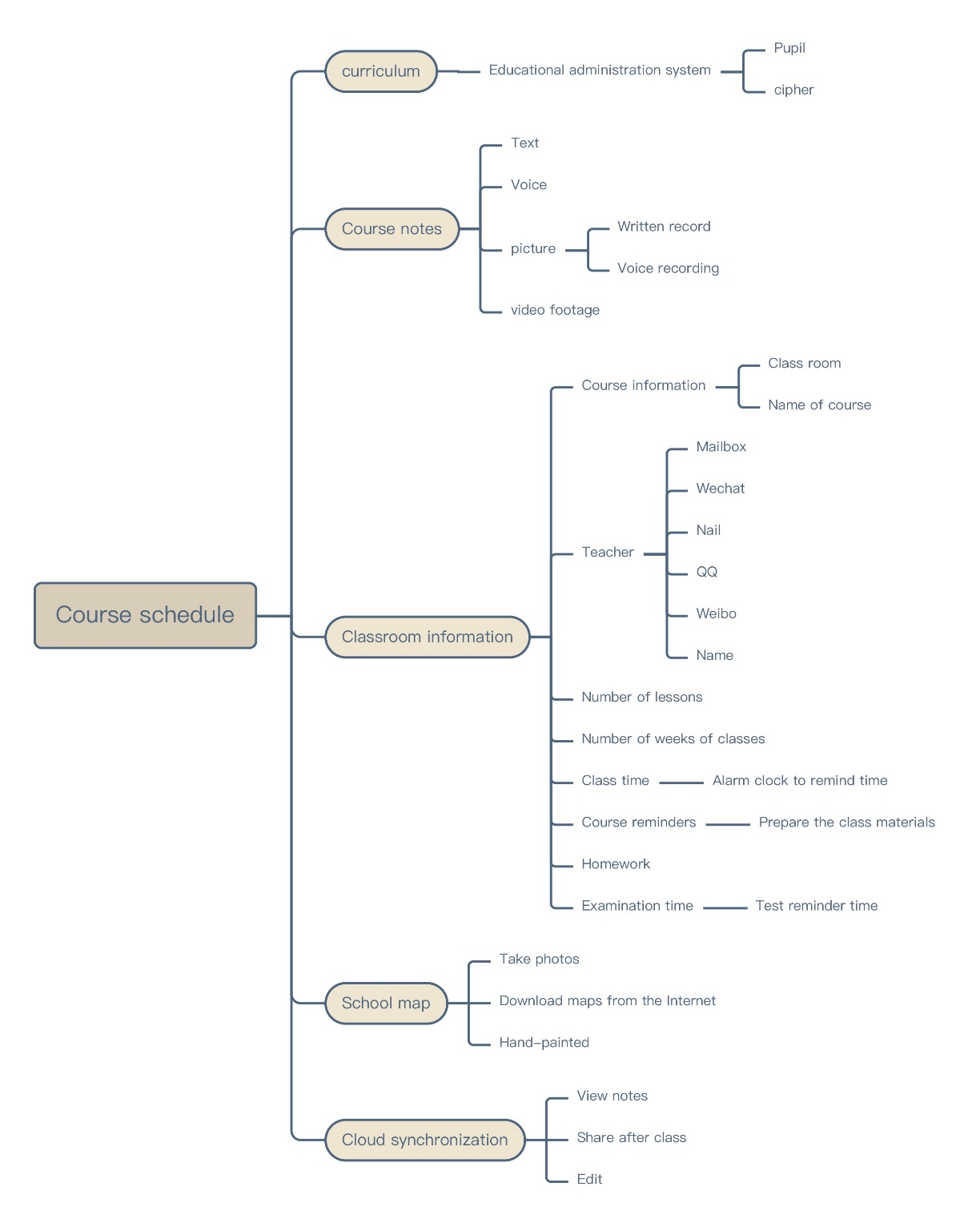
Figure 3. Preliminary mental model construction.
4. Experimental results and analysis
4.1. Mental model analysis
Based on the design considerations mentioned above, this study determined the information steps and connections in the course schedule navigation bar of the college student management system app. The course schedule is a widely used navigation bar, and the functional settings based on it are in line with the cognitive abilities of college students. From the course schedule, users can access course notes, course information, school maps, and cloud synchronization. The app can quickly add required and elective course schedule information based on the information provided by students during registration. Users can also manually add or delete individual courses. By clicking on a specific course in the schedule, users can access the navigation bar for course notes and course information. The course information section includes nine aspects: course name, classroom, instructor, class periods, weeks, class time, course reminders, homework assignments, and exam time. Users can switch between these aspects by clicking on the corresponding position. The course notes section presents notes in a format corresponding to the classroom. Notes can be recorded in text or audio form, and users can also mark the notes for later editing and organizing. Notes can be added in four formats: text, audio, images, and videos. In the image format, multiple text and audio annotations can be added to meet the different needs of users for different teachers and types of courses in various situations. The school map navigation bar primarily helps freshmen quickly locate their classrooms and avoid getting lost on the way. The map can be added in three forms: online search and download, taking photos of the teaching building, and self-drawn maps to enhance memorization with an element of fun. The last navigation bar is the cloud synchronization feature, which enables information synchronization between the mobile and desktop versions of the management system. The desktop version can permanently store key knowledge from multiple semesters and save notes into folders for easy future organization, viewing, and sharing.
4.2. Card sorting analysis
From the card sorting results, it is evident that participants categorized the cards as follows: 1) Participants tended to place frequently used navigation content in the top-level navigation bar for easy access. For example, the results show that college students prefer to group similar labels together. Moreover, the constructed mental model chart indicates that many college student management system course schedule app homepages place the entry points for “viewing notes” and “post-class sharing” under the “cloud synchronization” category. This can make it difficult for users to understand the categorization. However, most participants clearly classified “school map” and “network download map” under the “cloud synchronization” category and placed “viewing notes” and “post-class sharing” under the “course notes” category. 2) Most card sorters preferred to further categorize the lower-level navigation labels under the top-level navigation bar into fourth-level categories. For example, participants placed “academic system” and “students” under the second-level and third-level navigation bars, respectively, for the “course settings” category. Additionally, “name” and “password” were individually placed as fourth-level navigation bars under the “academic system” navigation bar.
4.3. Cluster analysis
Cluster analysis is often used to test the distances between different entities, classify them based on the closeness of their spatial relationships, and present the results in the form of a dendrogram. The card sorting results of each participant were organized, and the processed data matrix was input into IBM SPSS Statistics 23 software for cluster analysis. The results of the cluster analysis are shown in Figure 4, dividing the information navigation of the management system app into four main categories:
The first category includes “class time”, “course name”, “classroom location”, etc.; the second category includes “name”, “academic affairs system”, etc.; the third category includes “viewing notes” and “editing”; and the fourth category includes “downloading maps” and “school map,” among others. Based on the specific meanings of each item in the navigation bar, these categories are summarized as follows: 1. Class information, 2. Course settings, 3. Course notes, 4. Cloud synchronization.
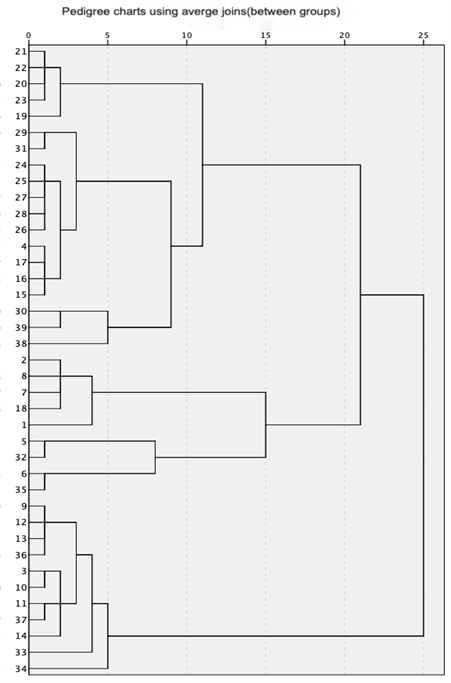
Figure 4. Dendrogram of average linkage (between groups)
5. Suggestions
The purpose of comparing the classification results of Experimental Group 2 and interviews is to verify whether the mental model constructed through interviews and follow-up investigations can provide better guidance. The card sorting test yielded more detailed clustering results, as users tend to group similar labels together. The data obtained from Experimental Group 2 was analyzed and compared with the results from Experimental Group 1 to validate the feasibility of the proposed improvements. Based on this, the following suggestions are proposed for the construction of a college student management system app:
1. Simplify the navigation bar information in the management system learning app. Place frequently used navigation information in the same level for better understanding and usability by students. For example, "course classroom" and "course name" can be merged under the top-level navigation bar. Students often overlook most non-essential information, and having too many navigation bars will result in a cluttered interface, thereby reducing learning efficiency.
2. Design the interface layout of the management system learning app in a rational manner. The preliminary mental model shows a reasonable classification for the next-level navigation bar under "instructors." However, for the purpose of facilitating efficient learning for student users, they prefer to have "class time" and "exam time" prominently placed under the "course information" category. Additionally, ensure that important information reminders, such as "exam reminder time" and "class time," are easily noticeable to avoid missing crucial notifications.
3. Use navigation information that is easy to understand and recognize. Ambiguous first-level navigation bars and information-dense hierarchical navigation can lead to excessive cognitive load and decrease student motivation. For example, the existing system's "hand-drawn" navigation is not easily understood by student users in terms of its specific purpose, resulting in reduced efficiency in using that navigation label.
4. When designing the information architecture of the management system learning app, consider student user behavior. Students log into the management system app to check course instructors, grades, class locations, etc., to better engage their learning motivation. For example, in the experiment, participants made full use of the navigation information for "course notes" and "course information." Participants also emphasized the use of navigation information like "exam time" and "class time reminder," anticipating an increase in usage frequency. In the busy daily lives of students, they may be distracted by other matters or forget due to long periods of time. The inclusion of an "alarm reminder" module can effectively address such issues and increase student usage.
5. Apply mental models and social psychology methods appropriately in the design process of the management system learning app. This approach will accurately construct a student-centered website. The improved information construction of the management system website is shown in Figure 5.
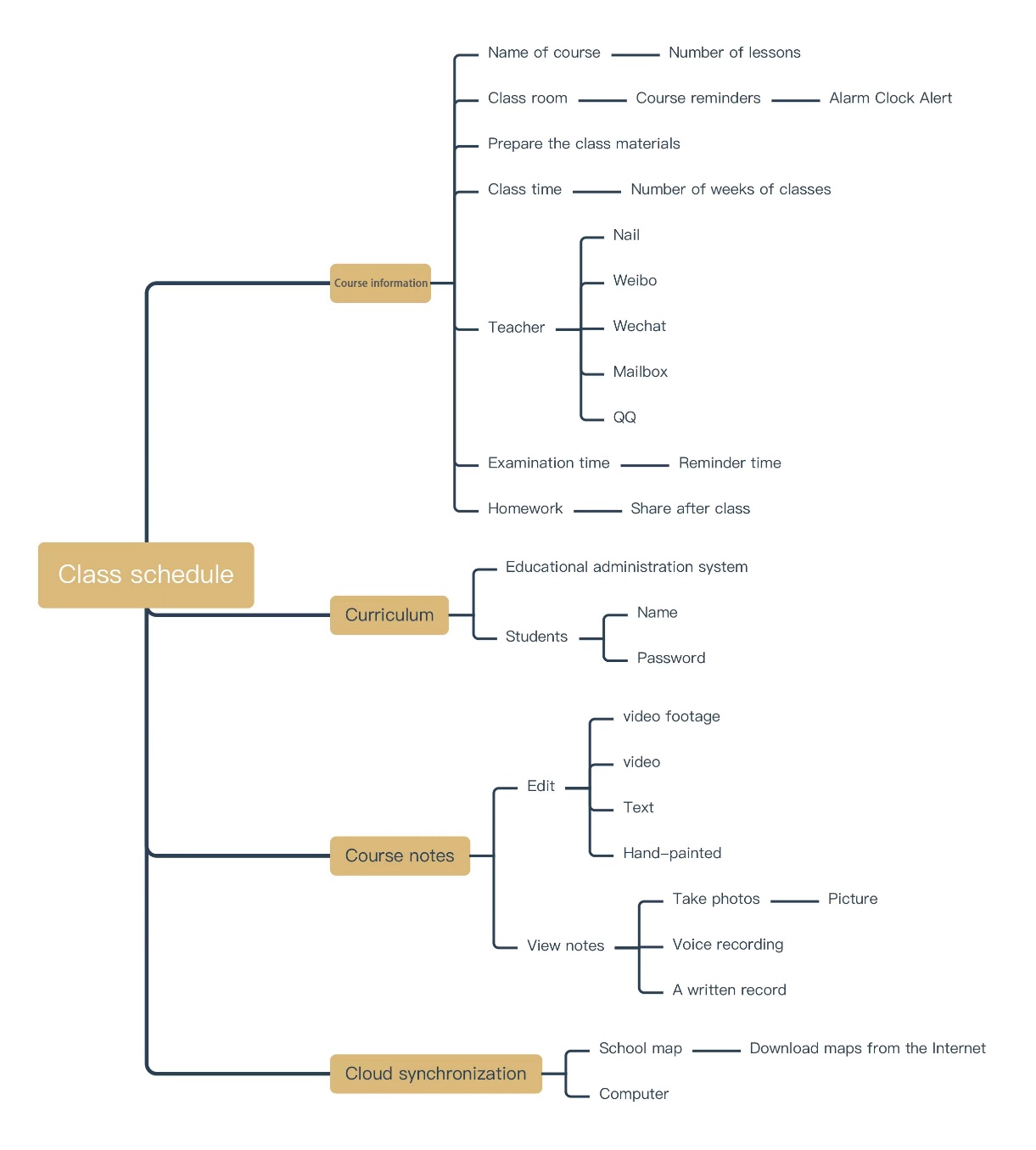
Figure 5. Improved information construction of the management system.
6. Conclusion
This study combines mental models with theories of design psychology to explore the design of a management system app that better matches the mental models of college student users. The student mental model constructed through the methods described above allows for a more comprehensive and targeted acquisition of information construction for a college student management system app. Furthermore, this study provides theoretical support for the construction and application of a college student management system app. Therefore, the design of a college student management system app based on mental models offers a theoretical basis and research methodology for the design of such apps in the field of mobile applications. Future research will focus on empirical studies regarding design elements and interaction details of this management system.
References
[1]. Survey and Reflection on the Current Learning Situation of College Students. (2008). Retrieved from http://bbs.ccnu.com.cn/frame.php
[2]. Hua, K. B. (2022). Transformation and Coping Strategies of Higher Education Management Mode for College Students in the Era of Big Data. Journal of Shanxi University of Finance and Economics, 44(S1), 84-86.
[3]. Mei, Y. (2011). Consistency Research on Mental Models and Information Construction and Its Application in Mobile Internet Software (Doctoral dissertation, Zhejiang University).
[4]. Luo, W. J. (2009). Application of ZMET Technology in the Mental Model of Smartphone Consumers (Doctoral dissertation, Southwest Jiaotong University).
[5]. Zaltman, G., & Coulter, R. H. (1994). Using the Zaltman Metaphor Elicitation Technique to Understand Brand Images. Advances in Consumer Research, 21, 501-507.
[6]. Tong, Q. (2012). Research on Target-oriented Mobile Payment Application Software Design (Doctoral dissertation, Jiangnan University).
[7]. Dou, J. H., Wei, X., & Zhao, X. H. (2009). Research on Product Design Based on User Mental Models. Packaging Engineering, (2), 125-144.
[8]. Zhang, Y. Q. (2012). Research on Mobile Terminal Application Design of Vehicle Ridesharing Service System Based on User Satisfaction (Doctoral dissertation, Zhejiang University of Technology).
[9]. Cheng, D. L. (2009). Research on Symbol Referencing Based on Mental Models in Product Design (Doctoral dissertation, Jiangnan University).
[10]. Zhao, P. W., & Dou, Y. X. (2010). Information Resource Management Technology. Beijing: Science Press.
[11]. Wang, X. Y., & Hu, C. P. (2006). Information Construction Based on User Experience. Information Science, (08), 1235-1238.
[12]. Craik. (1943). The Nature of Explanation. Cambridge: Cambridge University Press.
[13]. Bai, C., Gan, L. R., & Zhu, X. C. (2009). Experimental Study on Decision Mental Model of Information Users. Information Studies: Theory & Application, 32(10), 94-98.
[14]. Zhang, N. N., Liu, X. H., & Yuan, H. (2018). Research on Open Card Classification of Digital Service Design Technology. Packaging Engineering, 39(20), 186-.
[15]. Morville, P., & Rosenfeld, L. (2006). Information Architecture for the World Wide Web. Cambridge: O'Reilly Media.
[16]. Doney, P. M., & Cannon, J. P. (1997). An Examination of the Nature of Trust in Buyer-Seller Relationships. Journal of Marketing, 61(2), 35-51.
[17]. Nielsen, J., & Sano, D. (1994). SunWeb: User Interface Design for Sun Microsystems' Internal Web. In 2nd World Wide Web Conference. Chicago: OSF RI.
[18]. Martin, S. (2013, July 25). Cluster Analysis for Website Organization: Using Cluster Analysis to Help Meet Users' Expectations in Site Structure. Retrieved from http://www.internettg.org/newsletter/dec99/clusteranalysis.html
[19]. Young, I. (2008). Mental Models: Aligning Design Strategy with Human Behavior. Rosenfeld Media.
[20]. Yang, Y., Liu, W., & Zhu, W. (2008). Analysis of Personal Preferences Influencing Buyer's Behavior under the B2C and C2C Mode. ACM, P2-4.
Cite this article
Shi-Shi,H.;Qin-Ling,D. (2023). Research on information construction of university management system app based on cognitive model. Applied and Computational Engineering,21,1-12.
Data availability
The datasets used and/or analyzed during the current study will be available from the authors upon reasonable request.
Disclaimer/Publisher's Note
The statements, opinions and data contained in all publications are solely those of the individual author(s) and contributor(s) and not of EWA Publishing and/or the editor(s). EWA Publishing and/or the editor(s) disclaim responsibility for any injury to people or property resulting from any ideas, methods, instructions or products referred to in the content.
About volume
Volume title: Proceedings of the 5th International Conference on Computing and Data Science
© 2024 by the author(s). Licensee EWA Publishing, Oxford, UK. This article is an open access article distributed under the terms and
conditions of the Creative Commons Attribution (CC BY) license. Authors who
publish this series agree to the following terms:
1. Authors retain copyright and grant the series right of first publication with the work simultaneously licensed under a Creative Commons
Attribution License that allows others to share the work with an acknowledgment of the work's authorship and initial publication in this
series.
2. Authors are able to enter into separate, additional contractual arrangements for the non-exclusive distribution of the series's published
version of the work (e.g., post it to an institutional repository or publish it in a book), with an acknowledgment of its initial
publication in this series.
3. Authors are permitted and encouraged to post their work online (e.g., in institutional repositories or on their website) prior to and
during the submission process, as it can lead to productive exchanges, as well as earlier and greater citation of published work (See
Open access policy for details).
References
[1]. Survey and Reflection on the Current Learning Situation of College Students. (2008). Retrieved from http://bbs.ccnu.com.cn/frame.php
[2]. Hua, K. B. (2022). Transformation and Coping Strategies of Higher Education Management Mode for College Students in the Era of Big Data. Journal of Shanxi University of Finance and Economics, 44(S1), 84-86.
[3]. Mei, Y. (2011). Consistency Research on Mental Models and Information Construction and Its Application in Mobile Internet Software (Doctoral dissertation, Zhejiang University).
[4]. Luo, W. J. (2009). Application of ZMET Technology in the Mental Model of Smartphone Consumers (Doctoral dissertation, Southwest Jiaotong University).
[5]. Zaltman, G., & Coulter, R. H. (1994). Using the Zaltman Metaphor Elicitation Technique to Understand Brand Images. Advances in Consumer Research, 21, 501-507.
[6]. Tong, Q. (2012). Research on Target-oriented Mobile Payment Application Software Design (Doctoral dissertation, Jiangnan University).
[7]. Dou, J. H., Wei, X., & Zhao, X. H. (2009). Research on Product Design Based on User Mental Models. Packaging Engineering, (2), 125-144.
[8]. Zhang, Y. Q. (2012). Research on Mobile Terminal Application Design of Vehicle Ridesharing Service System Based on User Satisfaction (Doctoral dissertation, Zhejiang University of Technology).
[9]. Cheng, D. L. (2009). Research on Symbol Referencing Based on Mental Models in Product Design (Doctoral dissertation, Jiangnan University).
[10]. Zhao, P. W., & Dou, Y. X. (2010). Information Resource Management Technology. Beijing: Science Press.
[11]. Wang, X. Y., & Hu, C. P. (2006). Information Construction Based on User Experience. Information Science, (08), 1235-1238.
[12]. Craik. (1943). The Nature of Explanation. Cambridge: Cambridge University Press.
[13]. Bai, C., Gan, L. R., & Zhu, X. C. (2009). Experimental Study on Decision Mental Model of Information Users. Information Studies: Theory & Application, 32(10), 94-98.
[14]. Zhang, N. N., Liu, X. H., & Yuan, H. (2018). Research on Open Card Classification of Digital Service Design Technology. Packaging Engineering, 39(20), 186-.
[15]. Morville, P., & Rosenfeld, L. (2006). Information Architecture for the World Wide Web. Cambridge: O'Reilly Media.
[16]. Doney, P. M., & Cannon, J. P. (1997). An Examination of the Nature of Trust in Buyer-Seller Relationships. Journal of Marketing, 61(2), 35-51.
[17]. Nielsen, J., & Sano, D. (1994). SunWeb: User Interface Design for Sun Microsystems' Internal Web. In 2nd World Wide Web Conference. Chicago: OSF RI.
[18]. Martin, S. (2013, July 25). Cluster Analysis for Website Organization: Using Cluster Analysis to Help Meet Users' Expectations in Site Structure. Retrieved from http://www.internettg.org/newsletter/dec99/clusteranalysis.html
[19]. Young, I. (2008). Mental Models: Aligning Design Strategy with Human Behavior. Rosenfeld Media.
[20]. Yang, Y., Liu, W., & Zhu, W. (2008). Analysis of Personal Preferences Influencing Buyer's Behavior under the B2C and C2C Mode. ACM, P2-4.





